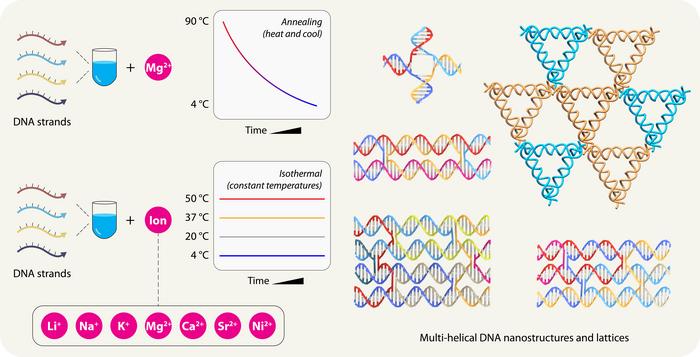University at Albany researchers are venturing into an innovative realm of DNA nanotechnology, significantly advancing the synthesis of DNA nanostructures. Their recent discoveries, spotlighted in the journal Science Advances, indicate groundbreaking approaches to fabricating these intricate nanoscale entities. Unlike conventional methods reliant on extreme thermal conditions, such as heating and cooling DNA solutions, the researchers have unveiled a strategy that allows for the assembly of DNA structures at room and body temperature, a watershed moment in the field.
This development stands as a testament to the potential of DNA beyond its conventional role as a carrier of genetic information. DNA’s unique properties enable it to serve as a versatile material, offering a canvas for researchers to engineer elaborate nanoscale configurations. By strategically designing the base pairs that constitute DNA strands, scientists can create structures tailored to foster the precise placement of biomolecules, cells, and nanoparticles. These developments open avenues for groundbreaking applications in the realms of medicine, materials science, and advanced data storage.
Traditionally, the formation of DNA nanostructures necessitated rigorous temperature controls, with DNA strands subjected to heat followed by cooling, typically involving magnesium-ion-buffered solutions. Such requirements have constrained real-world applications due to the challenges associated with maintaining specific temperature settings. Moreover, the use of magnesium can lead to structural vulnerabilities in biological contexts, further complicating their potential use in therapeutic environments.
In a significant shift, the research team from UAlbany explored alternative methods that incorporate varied metal ions in different buffer solutions. The researchers demonstrated that DNA nanostructures could be successfully assembled isothermally at significantly lower, constant temperatures. These finding not only simplifies the synthesis process but also enhances the structural stability of the resulting nanostructures, thereby broadening their applicability in biomedicine and materials engineering.
Lead researcher Arun Richard Chandrasekaran explained the transformative nature of these findings, highlighting that their novel approach eliminates the reliance on sophisticated thermal cycling equipment. By assembling DNA nanostructures at moderate temperatures, the methodologies proposed by the team simplify the entire process of nanostructure synthesis, paving the way for practical applications in diverse fields. This new approach is particularly significant as it reduces thermal stress, protecting temperature-sensitive biomolecules that are often incorporated into artificial nanodevices.
The research illuminates pathways for using temperature-sensitive proteins—such as antibodies and enzymes—in conjunction with DNA nanostructures. By mitigating temperature-related risks during assembly, researchers can create refined DNA nanodevices potentially useful for drug delivery systems and diagnostic tools. This alignment of nanotechnology with biological applications highlights a promising future where tailored treatments might become possible.
Chandrasekaran’s enthusiasm underscores the transformative impact of the new findings, “This work brings us closer to imagining how these nanostructures could actually be made and used in the human body for applications like targeted drug delivery or precision diagnostics.” He emphasizes that while more research is needed before practical implementations can materialize, the ability to construct DNA nanostructures at physiological temperatures represents a significant milestone.
The collaborative research effort by the UAlbany team incorporated several different metallic ions in their studies, moving beyond traditional components to include nickel and strontium. These additions reveal the capacity for successful assembly at both ambient and body temperatures, diverging from previous reliance on magnesium ions. The immediate implication is a broader toolbox for scientists looking to craft DNA nanostructures that are easier to manipulate and deploy.
Chandrasekaran and his team propose to persist in this line of inquiry, aspiring to refine assembly techniques across various metal ions while rigorously assessing the biostability of the generated nanostructures. The goal is to create innovative nanotechnological solutions capable of addressing complex problems prevalent in medicine, health, and beyond.
The implications of these advancements resonate on numerous levels, suggesting novel methods that could expedite the design and production of biologically-compatible nanostructures. The collaboration extends beyond the UAlbany lab, attributing to the support from prestigious institutions including the National Institutes of Health and the U.S. Army Medical Research Acquisition Activity. This multidisciplinary approach also emphasizes the collaborative ethos essential in tackling challenging scientific questions that blend biology with nanotechnology.
The published research not only adds empirical weight to the foundation of DNA nanotechnology but also encourages dialogue around its future applications. As interdisciplinary teams continue to push the boundaries of biomedical research, the landscape of how DNA nanostructures can be cultivated and employed will undoubtedly evolve, promising a future rich with possibilities for innovation and discovery.
As the field stands at this essential crossroads, remaining cognizant of the implications and responsibilities tied to these advancements is crucial. The fusion of DNA technology with practical applications could redefine therapeutic protocols, while instilling the importance of ethical considerations in research and its applications. As DNA nanotechnology evolves, society must contemplate both the opportunities and challenges it presents, nurturing a balanced approach as the scientific community strives for transformative discoveries.
In conclusion, the pioneering work conducted by the UAlbany researchers opens thrilling new pathways for DNA nanostructure assembly, setting the stage for revolutionary applications across medicine and material science. By forging ahead in this promising line of research, they contribute significantly not only to our understanding of DNA but also to the membrane between technical achievement and biological utility, ultimately enhancing human health and potential.
Subject of Research:
Article Title: Counter ions influence the isothermal self-assembly of DNA nanostructures
News Publication Date: March 12, 2025
Web References:
References:
Image Credits: Arun Richard Chandrasekaran, University at Albany.
Keywords
Tags: advanced applications of DNA nanostructuresadvanced data storage solutionsbiomolecule placement in DNA structuresDNA as a versatile materialDNA in medicine and materials scienceDNA nanotechnologyinnovative DNA nanostructure assemblynanoscale configuration engineeringroom temperature DNA synthesisScience Advances publication on DNA researchtemperature-controlled DNA fabricationUAlbany research breakthroughs





